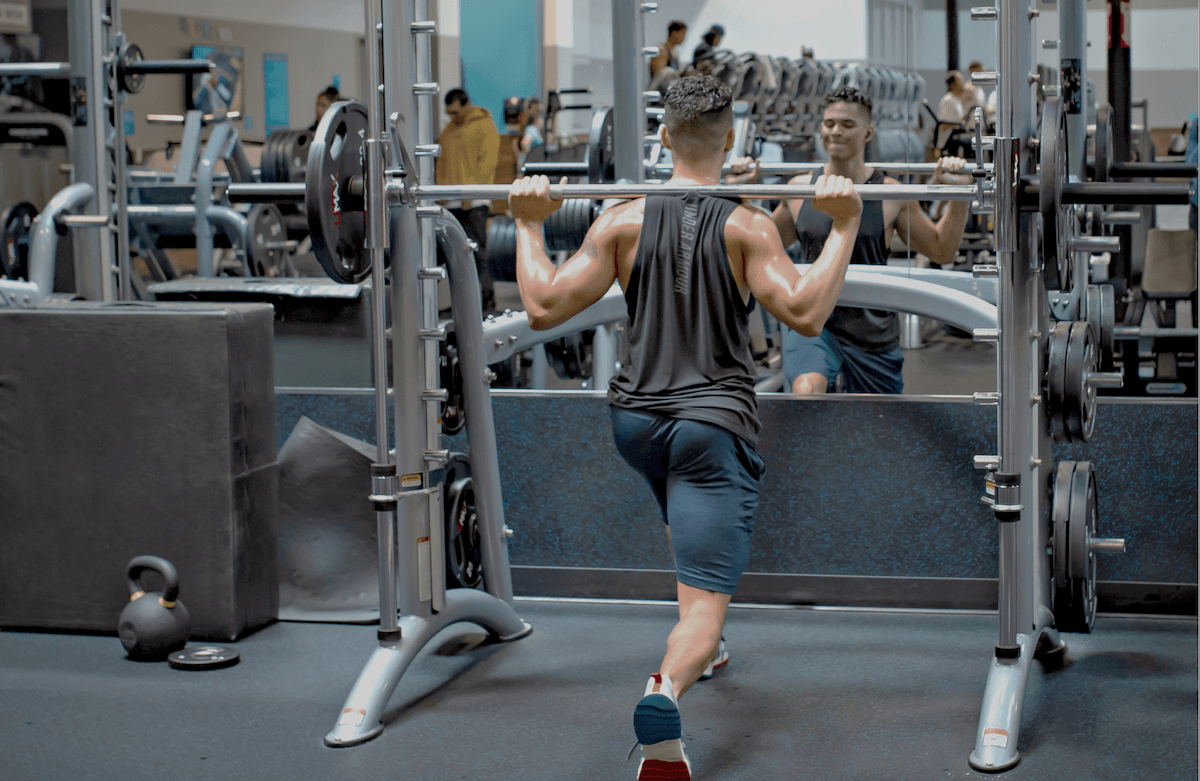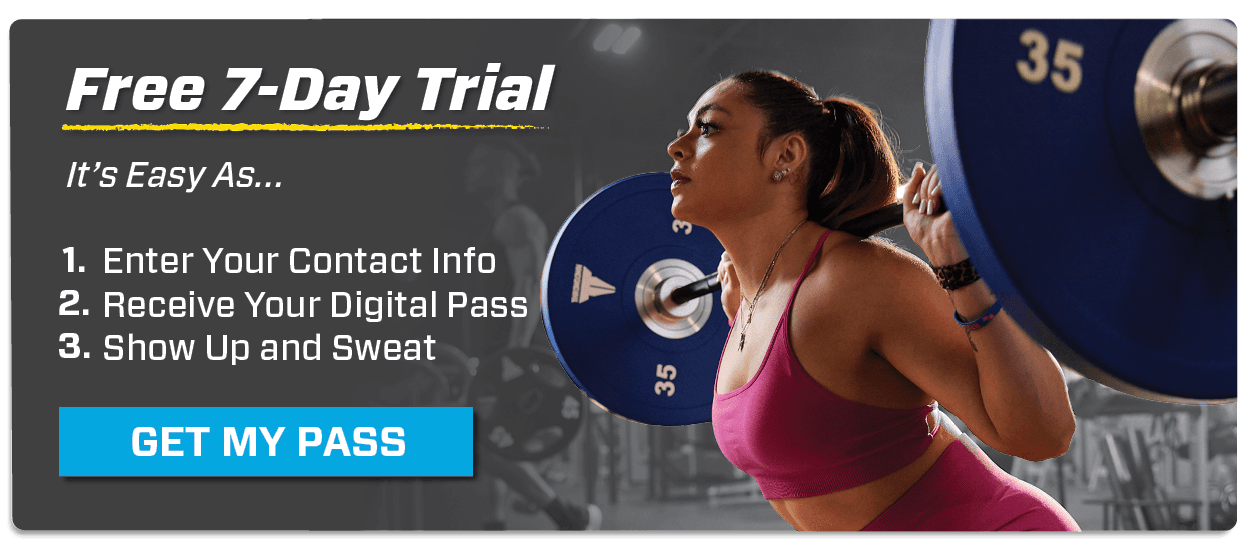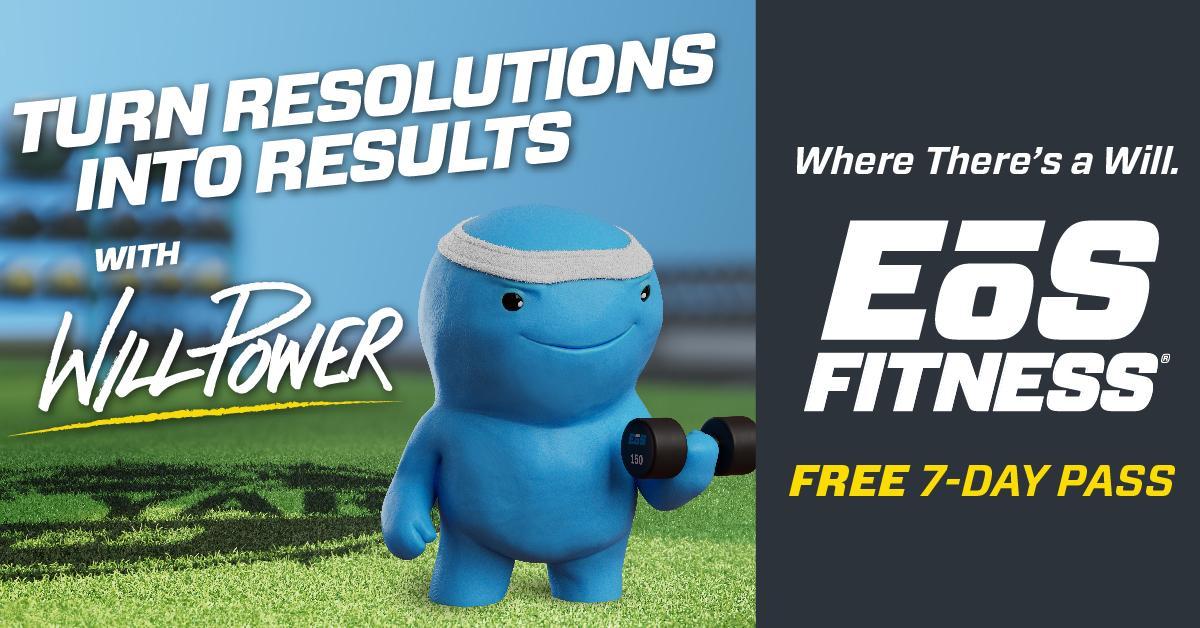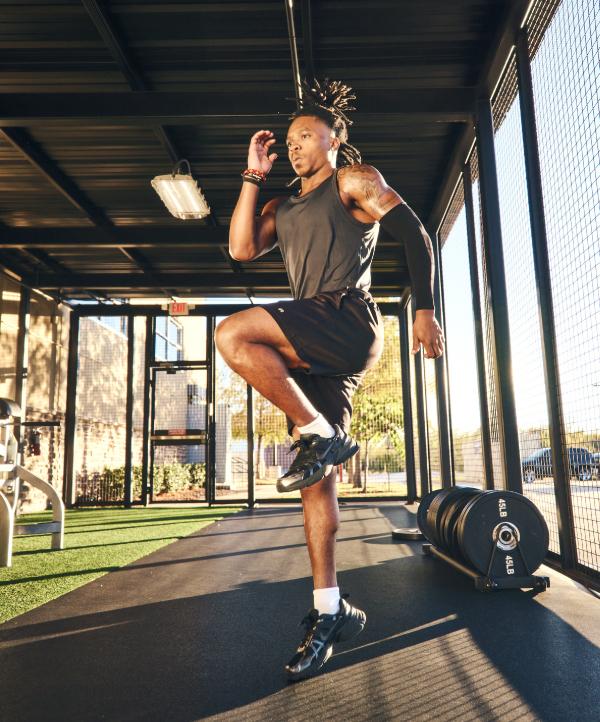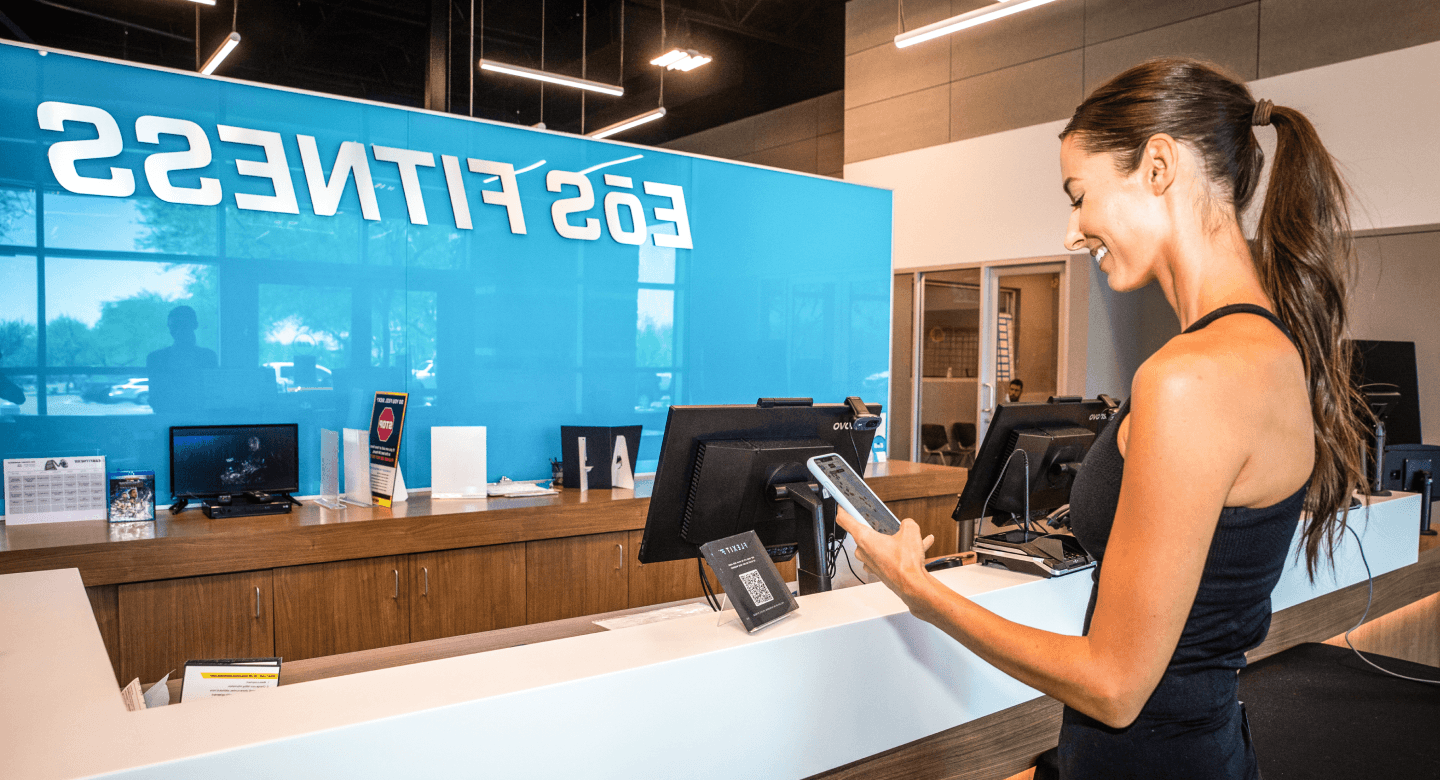WHAT IS A SMITH MACHINE? HOW IT WORKS AND WHEN TO USE IT AT THE GYM
Fitness Tips
Aug 25, 2025 • 10min read
The Smith machine might look a little intimidating at first, but it’s one of the most beginner-friendly tools you’ll find on the gym floor. With its sturdy guide rails and built-in safety stops, the Smith machine helps you lift with control and confidence. Whether you’re just learning how to squat or need backup during a solo chest day, this machine has your back. In this guide, we’ll walk you through everything you need to know, from how it works to exercises you can try on your own!
WHAT YOU WILL LEARN
- What is a Smith machine?
- How to use a Smith machine safely
- Types of Smith machines you might find
- Pros and cons to consider
- Where it fits into your workout plan
- Smith machine exercises for legs, chest, glutes and back
- Pro tips to get more from every rep
- How to start using it with a Complimentary 7-Day Pass
WHAT IS A SMITH MACHINE?
A Smith machine is a piece of gym equipment that blends the barbell setup of free weights with the guided stability of a machine. The bar is fixed to steel rails, so it moves only up and down, either straight or slightly angled. Unlike free weights, the Smith machine has built-in hooks and safety stops. That means you can rack the bar at any time, giving you more control and support during lifts. It’s a great option if you’re working out alone or learning proper form.
Key Features:
- Fixed barbell on rails: Keeps your motion straight
- Safety stops: Set limits to catch the bar if needed
- Twist-and-lock hooks: Secure the bar with a simple wrist turn
- Solo-friendly: Perfect for training without a spotter
- Available at most EōS Fitness locations
HOW TO USE A SMITH MACHINE SAFELY
Using the Smith machine might look straightforward but knowing how to set it up properly makes a big difference in safety and performance. Whether you’re squatting, pressing or rowing, taking a few minutes to adjust the machine to your body will help you move with confidence and avoid unnecessary strain. Here’s a simple setup guide to get you started the right way.
- Position yourself correctly: Line up your body so the bar rests where you’d naturally start the lift.
- Adjust the safety stops: Set the safety stops just below your lowest movement point to catch the bar if needed.
- Start with light weights: Try using just the bar or lighter plates to get comfortable with the motion.
- Unrack with control: Rotate your wrists forward to unlock the bar from the hooks.
- Perform slow, steady reps: Focus on control and form rather than speed.
- Rerack securely: Rotate your wrists back to lock the bar into place when you’re done.
- Ask an EōS Team Member if needed: Don’t hesitate to get guidance; your safety matters. EōS team members are always available to help you set up equipment and ensure you’re lifting confidently.
TYPES OF SMITH MACHINES (AND HOW TO SPOT THE DIFFERENCE)
While the basic function of a Smith machine stays the same, not all models are built equally. Understanding the differences can help you feel more prepared when stepping into a new gym or trying a new variation. Each machine type has subtle changes in bar path and feel, which may affect your comfort or the way you perform a movement.
At EōS, you’ll commonly find:
- Vertical path models: The bar moves straight up and down. Best for standard squats, glute bridges and rows where you want to maintain a strict vertical path. These machines are ideal for beginners working on form.
- Angled path machines: The bar travels slightly back as it rises. This design mimics the natural movement of exercises like back squats and incline presses. It can help you shift your weight back into your heels during squats, making it easier to sit deeper and activate your glutes and hamstrings. Ideal for those working on squat depth or posterior chain engagement.
- Counterbalanced machines: The bar feels lighter, making starting and controlling your reps easier. This version is helpful for beginners or for exercises that require control through an extensive range of motion, like Bulgarian split squats or deep glute bridges, where balance and setup matter more than the weight.
PROS AND CONS OF THE SMITH MACHINE
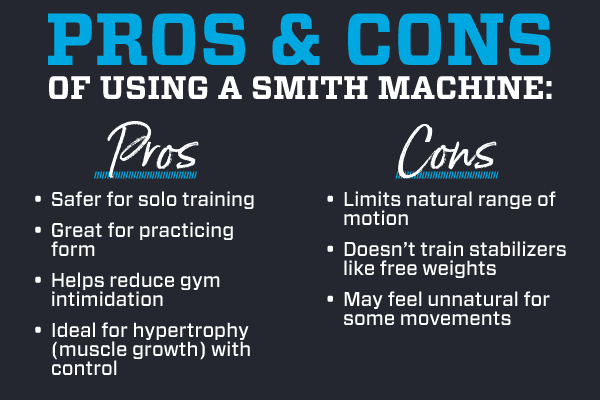
Like any piece of gym equipment, the Smith machine has strengths and limitations. Knowing both helps you decide when and why to include it in your routine.
Pros:
- Built-in safety support: With safety stops and a guided bar path, you can lift heavy or go deep into movements without needing a spotter. That makes it ideal for solo workouts or days when you want extra peace of mind.
- Great for learning form: The fixed path helps you lock in body alignment and focus on technique. Whether you’re a beginner or dialing in your squat depth, the Smith machine takes balance out of the equation so you can zero in on form and build confidence
- Muscle isolation and hypertrophy: Because you don’t need to stabilize as much, you can better isolate specific muscles, which is perfect for hypertrophy-style training where the goal is to feel the burn and build volume.
Cons:
- Limited range of motion: The fixed bar path doesn’t always match your body’s natural movement, which can feel restrictive or awkward, especially on exercises like deadlifts or overhead presses.
- Less engagement of stabilizer muscles: Since the bar is guided, your body doesn’t need to work as hard to balance the weight. Over time, this may limit functional strength gains if you rely on it too much.
- Not ideal for every lift: Some movements, like deadlifts, Olympic lifts or full-range overhead pressing, are better done with free weights due to their dynamic nature. The Smith machine can help prep for these lifts but shouldn’t entirely replace them.
New to the gym floor? Check out our Beginner’s Guide to Gym Equipment.
WHERE THE SMITH MACHINE FITS INTO YOUR WORKOUT ROUTINE
The Smith machine isn’t just a beginner’s fallback; it’s a versatile piece of gym equipment that fits into many training goals:
- Form-focused warm-ups: Start your workout with lighter Smith machine sets to fine-tune your technique before moving to free weights.
- Solo session staple: No spotter? No problem. Use the Smith machine on days you’re training solo for lifts like squats, lunges or bench presses without sacrificing safety.
- Muscle isolation: Take balance out of the equation and zero in on specific muscle groups—perfect for hypertrophy training or refining your mind-muscle connection.
- Smart programming: Pair Smith machine work with free weights throughout the week to keep your workouts well-rounded and progressive.
Not sure when to use machines or free weights? Learn which option fits your fitness goals best.
SMITH MACHINE EXERCISES TO TRY
Looking to build strength but not sure where to start? Try adding a few of these beginner-friendly Smith machine exercises into your next workout:
Smith Machine Squat Exercises
- Back Squats: Step under the bar and rest it on your upper traps. This position helps you maintain an upright torso and encourages proper knee alignment as you sit back into the squat. Unhook the bar, then squat down by pushing your hips back and bending your knees. Keep your chest up and drive through your heels to return to standing.
- Front Squats: Position the bar across the front of your shoulders. Cross your arms over the bar or use an underhand grip to keep it secure. With a tall spine, squat down slowly while keeping your elbows lifted. Press through your heels to rise back up. This variation lights up your quads and reinforces core stability.
- Split Squats or Reverse Lunges: With the bar on your upper traps, step one leg back into a lunge. Lower your back knee toward the floor, keeping your front knee in line with your toes. Push through your front heel to return to standing, then switch legs. The fixed path keeps you balanced, allowing you to focus on driving through your front heel.
- Wide-Stance or Glute-Focused Squats: Rest the bar on your upper traps, then stand with feet wider than shoulder-width apart and toes angled out. Squat down by pushing your hips back and knees out. Push through your heels to fire up your glutes and hamstrings.
Want to go deeper? Learn more about how to master the traditional squat or explore different squat variations.
Smith Machine Chest Exercises
- Flat Bench Press: This exercise is a safer way to build pressing strength in your chest and triceps without needing a spotter. Lie flat on the bench with the bar positioned above your chest. Grip the bar slightly wider than shoulder-width, lower it slowly to your chest, then press it back up until your arms are extended.
- Incline Bench Press: Targets your upper chest with controlled angles and less shoulder strain. Set the bench to a slight incline. Lie back and grip the bar just outside shoulder-width. Lower the bar to your upper chest in a controlled motion, then press it up to full extension to target your upper pecs.
- Tempo Presses: Perform your flat or incline bench press using a slower pace—typically lowering the bar for a 3–5 second count, pausing briefly at the bottom, then pressing up. This builds bar control, grip awareness and strengthens each phase of the lift
New to benching? Learn how to improve your chest press form.
Smith Machine Glute & Leg Exercises
- Glute Bridges: Great for building lower-body power. Sit on the floor with your upper back against a bench. Roll the bar over your hips and plant your feet shoulder-width apart. Drive through your heels to lift your hips until your body forms a straight line from shoulders to knees. Squeeze your glutes at the top, then lower down.
- Step-Ups or Static Lunges: Rest the bar across your upper traps. For step-ups, step onto a bench or box with one foot, drive through that heel to stand tall, then lower down with control. For static lunges, keep one foot forward and one back, then bend both knees to lower into a lunge. Press through the front heel to return to start. The guided bar keeps you balanced as you build strength one leg at a time.
- Bulgarian Split Squats: With the bar on your upper traps, place your back foot on a bench behind you. Lower your back knee toward the floor while keeping your front knee aligned over your ankle. Drive through the front heel to rise back up, engaging your glutes and core. Use the bar for support as you develop coordination, glute power, and hip stability.
Want to build stronger glutes? Explore more glute-focused workouts and tips for proper form.
Smith Machine Back Exercises
- Bent-Over Rows: Pull the bar toward your lower ribs to target the lats and mid-back. Keep your back flat and focus on the squeeze.
- Upright Rows: Lift the bar to chest height to work your traps and shoulders with precision.
- Barbell Shrugs: Keep it simple and effective. Use slow, steady reps to isolate and strengthen your upper traps.
Want to train your back like a pro? Check out these top exercises for a stronger back.
TIPS TO GET THE MOST OUT OF EVERY SMITH MACHINE WORKOUT
With just a few adjustments and a smart approach, the Smith machine can help you level up your workouts without the guesswork. These pro tips will help you stay consistent and see results.
- Use mirrors to check your form: Visual feedback helps you stay aligned.
- Slow down your reps: Controlled movement is safer and more effective.
- Switch up your angles: Try different foot placements or grips to target new muscle groups.
- Pair with finishers: Add bodyweight moves or machine sets for a full-body challenge.
- Leave it better than you found it: Rerack weights and wipe down your station when you finish your sets.
BUILD CONFIDENCE WITH A 7-DAY FREE TRIAL AT EōS
The Smith machine is just the start. At EōS, you’ll find a community, expert guidance and equipment to support every step of your fitness journey. Whether you’re just getting started or leveling up, a 7-Day Free Trial is the perfect way to explore everything we offer, on your terms.
